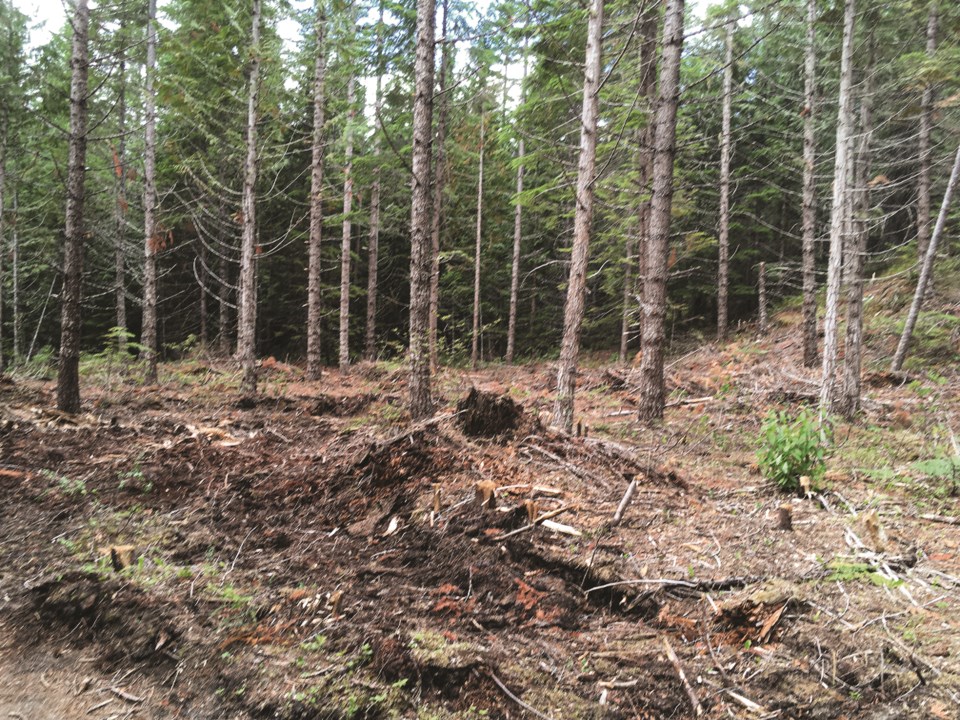Whistler's mayor and council has formally referred an independent local study into the effects of fuel thinning to its staff after its author submitted it to them with a request the practice be stopped—but told her one study was unlikely to change policy on the matter.
Speaking at the Sept. 10 regular council meeting during the public comment period, Dr. Rhonda Millikin, a retired ecologist, submitted her self-funded, peer-reviewed study and stressed the weight of the work put in, and the implications of its findings.
“Fuel-thinning compromises the natural resilience of Whistler’s forest to wildfire,” she said.
“Fuel-thinning increases solar radiation, wind speed and ambient air temperature, and decreases relative humidity and dead fuel moisture … The combined effect that we observed was a 58-per-cent increase in wildfire potential in spring, and a 37-per-cent increase in wildfire potential in late summer.”
Millikin’s study, co-authored by herself, a fire scientist, and a professor of statistics, was published in August after years of research and review. Shared with media after publication, the study tested Millikin’s hypothesis that fuel-thinning—being the removal of undergrowth in a bid to reduce fuel for potential fires—had the opposite effect to its stated goal. Fuel-thinning is a widespread practice, and in Whistler is part of wider wildfire mitigation efforts.
In submitting her study, Millikin challenged Whistler's council by asking what else was needed to stop the practice.
In response, Mayor Jack Crompton said the Resort Municipality of Whistler (RMOW) accepted a lot of input on fire safety and would be referring the study to staff for them to dig into, but added the results of one study are not enough to change course.
“We’re not going to be making policy based on a single paper. We’re going to be making policy based on the best information we can collect from experts in the field and from our professional staff here,” he said.
Millikin pressed on, asking the RMOW to divert funding from fuel-thinning to establish "green breaks" and sprinklers on the edges of the community, and criticizing the science behind FireSmart, which is another component of Whistler’s wildfire mitigation efforts aimed at properties in the community, encouraging fuel-thinning in neighbourhoods.
“The current practices for FireSmart are based on principles of fuel-thinning, and as such, our paper … also justifies a stop of FireSmart while we pilot green fuel breaks, rainwater catchment and sprinklers,” she said.
She suggested incentives move away from FireSmarting of property, to encouraging rainwater catchment, sprinklers, and green fuel breaks on private property instead.
Crompton said policy changes can’t be made on such short notice, while the RMOW’s general manager of climate action, planning and development services, Dale Mikkelsen, spoke about the RMOW’s fuel-thinning monitoring program, which is ongoing and expected to be complete by the end of 2025. That data will inform whether the program needs to be updated.
Mikkelsen stressed that fuel-thinning is one part of the overall wildfire mitigation works at the RMOW, and added they welcomed the study by Millikin into the procedure as important information.
“Fuel-thinning and FireSmarting is a new process for all of us," he said. "It's something that we’re invested in and the safety of the community is very important to us, so this research is an important addendum to the work we’re doing and we look forward to reviewing that.”
After the public comment period, and in receiving the study and referring it to staff for review, councillors were receptive to the work done, but expressed some misgivings about the reliance on the community’s limited water in sprinkler systems for fire security.
Councillor Cathy Jewett said the RMOW has “limited resources” as far as that idea goes, but added non-potable water used in irrigation for parks is in use already. “That’s something we certainly need to do more of,” she said.
Coun. Arthur De Jong said he appreciated the science, but went on to say frontline experiences point to the effectiveness of fuel-thinning.
“There’s science, but there’s also the experiences from the frontline,” he said, using the 2015 Elaho fire as an example.
“The fire experts came to me and they said Coastal fire behaviour has changed, the fires now … burnt into mineral soil. They advised me I had to rethink the safety of our ski area."
De Jong was previously the senior manager of planning and environment with Whistler Blackcomb, and spoke of some of the efforts made to ensure fire security, which included fuel-thinning on certain parts of the mountain.
“We’ve had some active fires, especially in the Crystal Zone, where we’ve been able to watch the fire behaviour move through thinned areas … We’ve found that [fuel-thinning has] given us a lot more capacity to fight the fires,” he said, explaining while stopping a fire in the canopy is difficult, in thinned areas it was easier to get to the fire.
“We need to take this science, I think it will help us adapt better where we need to do the interface thinning and where not to, so I certainly receive it with open arms,” he said.
Lastly, he spoke of the impact of climate change on the region. The Coastal forest, he said, was unlikely to have the characteristics of a Coastal forest with higher humidity for much longer—but rather, Interior forests.
“With the climate research that I’ve done, when our temperatures over the next 20 to 40 years go up three to five, six degrees C, we will be in more of an Interior climate," he said. "So there’s a lot more to discuss here, but certainly the experiences from the frontline are very compelling, that when fuel-thinning is done at locations, it really makes a difference.”
Councillors voted unanimously to receive the study from Millikin, and refer it to staff.




